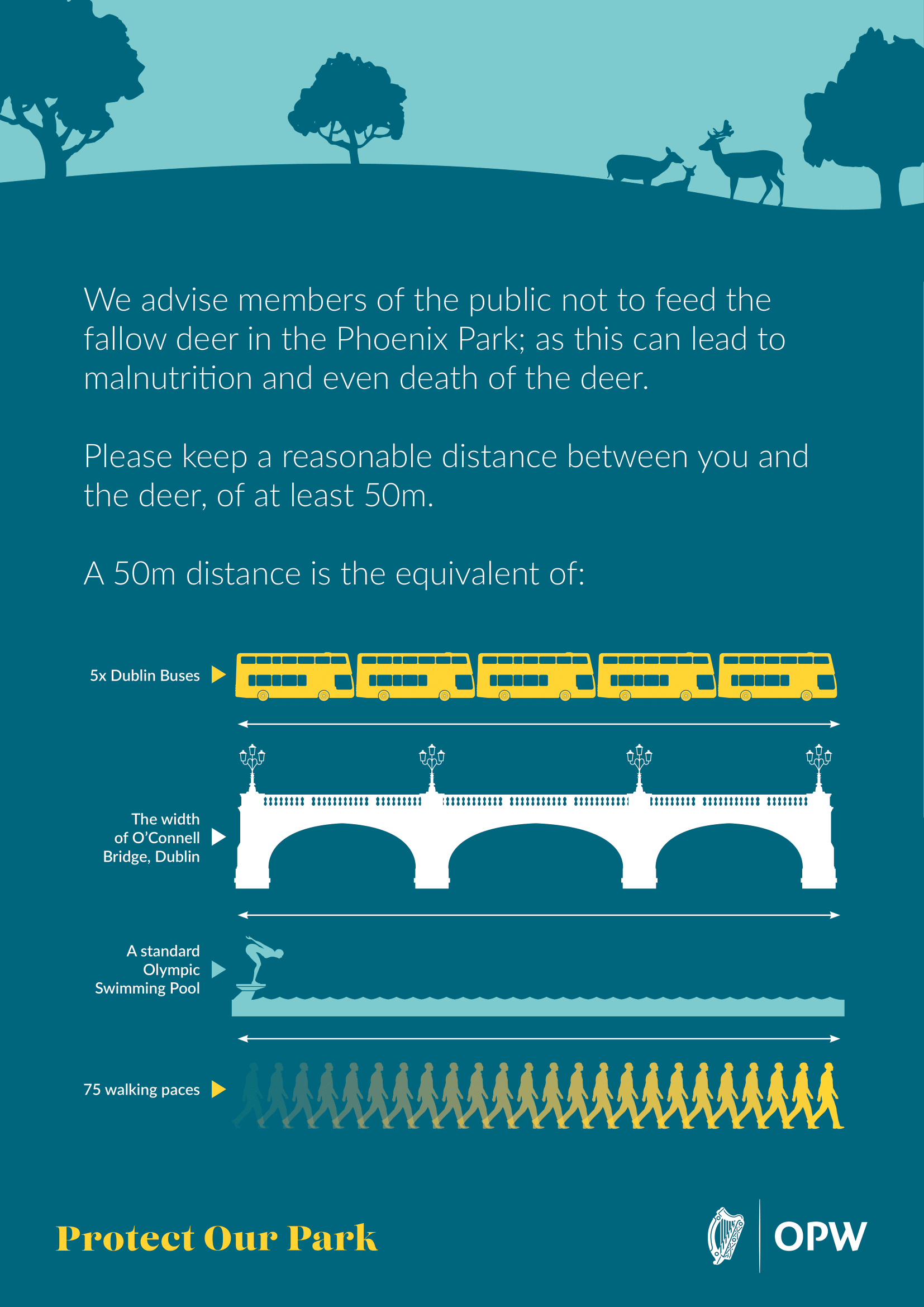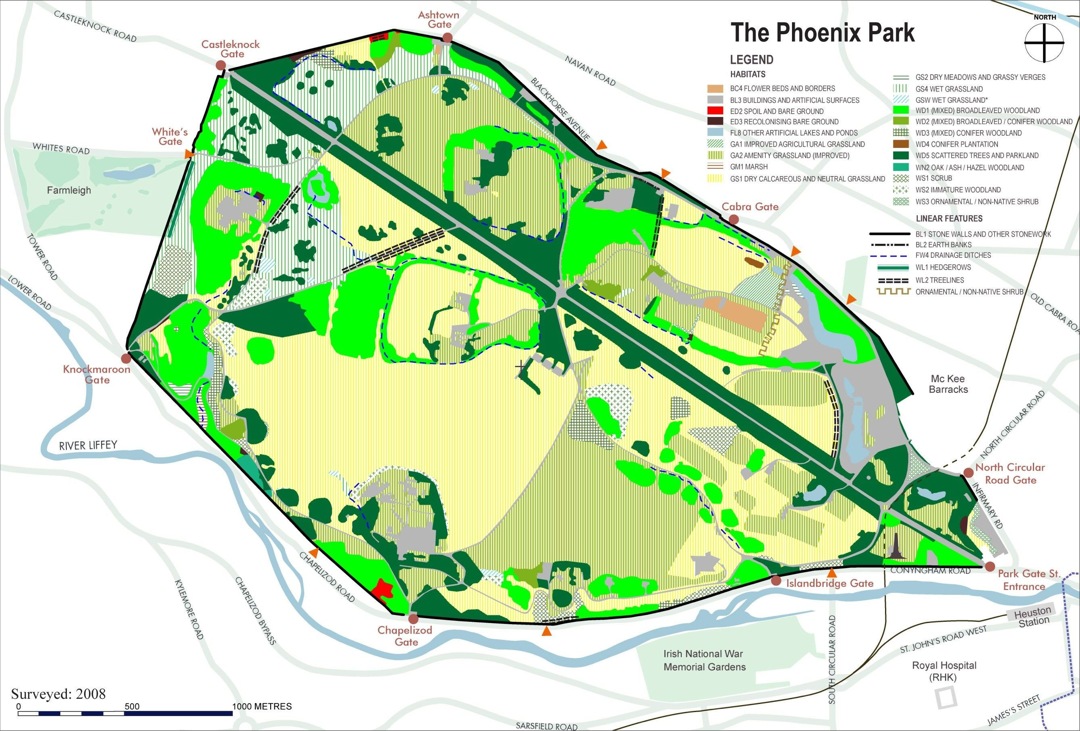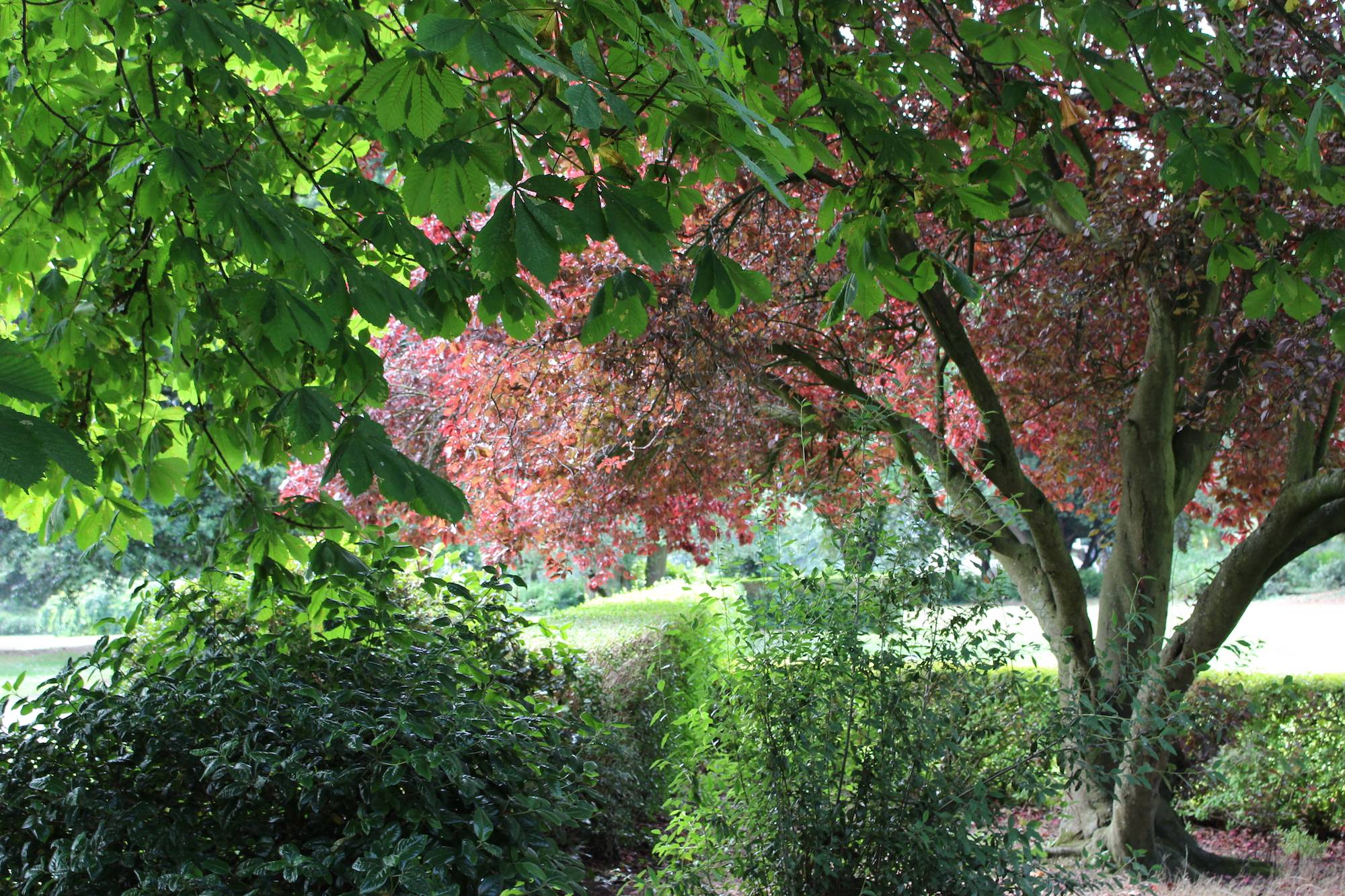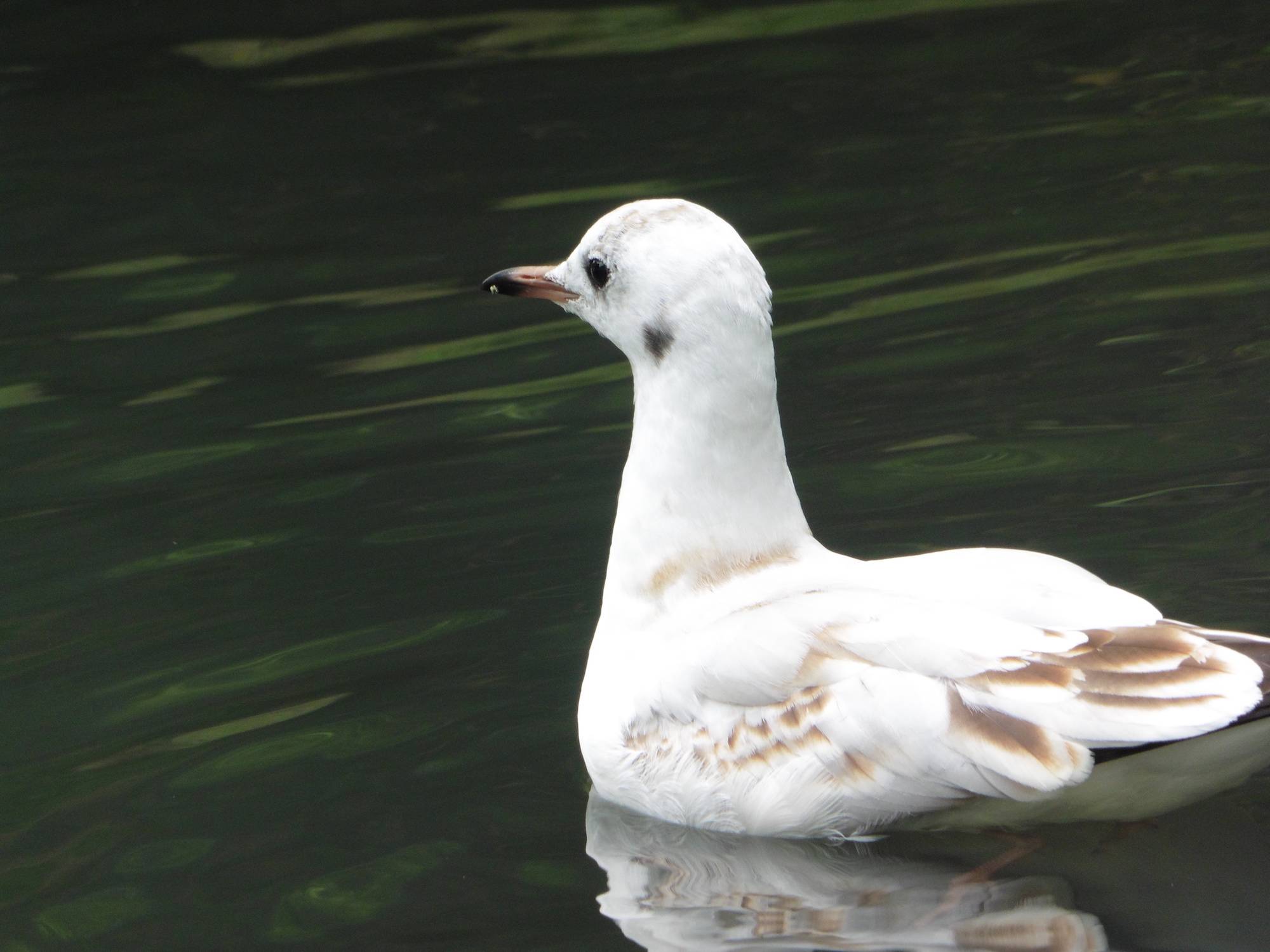Wild Deer Herd
Fallow deer are not native to Ireland but are now the most widespread around the country. The Normans first introduced fallow deer to Ireland in 1244 when they brought the deer over to stock the Royal Deer Forest, Glencree, Co. Wicklow.
When the Phoenix Park was established in 1662 by the Duke of Ormond, it was originally opened as a Royal Deer Park and the fallow deer were imported from Great Britain. The wild herd currently in the Park consists of approximately 600 deer, many of whom are descendants of the original herd introduced in the 1660s.
Important Notice
We advise members of the public not to feed the fallow deer in the Phoenix Park. Please keep a reasonable distance between you and the deer, at least 50m.
For more information on the Fallow Deer in the Phoenix Park please see Phoenix Park Deer Frequently Asked Questions
Public Advice signs below.
The Phoenix Park is a highly important site for biodiversity in Dublin City and is an extremely valuable resource for the people of Dublin and its visitors. It supports 50% of the mammal species found in Ireland and about 40% of bird species.
Among the 351 different plant species to be found in the Park there are three which are rare and protected. The Park has retained almost all of its old grasslands and woodlands, and also has rare examples of wetlands. In addition, the Phoenix Park is the location of Dublin Zoo, which interprets aspects of biodiversity to over 900,000 people each year.
One animal in particular, the fallow deer, was directly responsible for the development of the Phoenix Park and almost 350 years later there still remains a very successful herd in existence.
The most recent report with regard to species is contained in a Biodiversity Audit, undertaken by Trinity College in 2020 of Áras an Uachtaráin. The results of which is available to view by clicking on the following link: Áras an Uachtaráin Final Species List
The Phoenix Park Species List is available to view by clicking at this link. We wish to thank all those who participated in Bioblitz 2012.
Biodiversity can be defined as the variability among living organisms, from tiny insects to tall trees, from all sources including among other things, terrestrial, marine and other aquatic ecosystems and the ecological complexes of which they are part; this includes diversity within species, between species and ecosystems.
When evaluating biodiversity particular value is given to native species and natural habitats (i.e. species and habitats which can be shown to be present in Ireland or in the Phoenix Park for a very long period). This approach considers more recent arrivals (plants and animals) as being of low interest.
The Phoenix Park has ongoing management measures that are sensitive to biodiversity. Such measures include wildlife-sensitive grass management, allowing trees to die naturally within conservation zones, and the minimal use of chemicals and fertilizers. Further measures will continue to be introduced in line with the proposals in the Phoenix Park Conservation Management Plan and best practice.
Flora
Buildings and roads cover 45% of Dublin City. In The Phoenix Park they cover only 7%. Almost the entire Park consists of green areas which are excellent for wild plants and wildlife. There are twenty-four different habitats (places where wild plants and animals live). Woodlands and tree-dominated areas cover 31% or 220ha, and grasslands cover 56% or 398ha. Habitats include six types of woodland, five types of grassland, as well as hedgerows, scrub, ponds, streams, and wet ditches.
Most of the grasslands in the Park were grazed and topped until the 1970s. Since then, with the removal of hay, the diversity of these grasslands has been improving. Extensive open areas of grassland such as the Fifteen Acres provide nesting sites for skylark. Grasslands, which are remote from the main thoroughfares, are not cut and thus provide food and shelter for invertebrates and cover for small animals. A rare type of grassland is found on the steep terraces on the south side of the Park. It has numerous colourful wild herbs including the rare and protected plant, Hairy Violet. Small areas of wet grassland, indicated by the presence of rushes, are found particularly near Oldtown Wood. In one of these is found another rare and protected plant, the grass meadow barley.
Plants
Important features of native floristic diversity within the Phoenix Park include the Hairy St John’s Wort on the edge of cleared woodland in the grounds of Áras an Uachtarái, Hairy Violet on the sand and gravel terraces at the south of the Park, and the grass Meadow Barley in the wet grassland near the outfall from the Quarry Lake. The former was not seen in the Park since the eighteenth century. Hairy Violet has been seen in previous decades, and is in decline, but no previous record has been made for the grass.
Important features of habitat biodiversity within the Phoenix Park include:
- High cover of ‘wood pasture’. This is a type of woodland not well described in Ireland. It is associated with the use of the Park by deer. Its quality depends on age of trees and presence of rare invertebrates.
- Semi-natural habitats which are rare in Ireland. As well as wood pasture they include:
- Species rich calcareous grassland along sand and gravel terraces in the south of the Park, the flora of which includes Hairy Violet, a protected species.
- Wet grassland, particularly south of the Quarry Lake where the flora contains another protected plant, the grass meadow barley.
- Semi-natural woodland (0.5ha) dominated by ash near the Furry Glen.
- Fringing wetland vegetation around the Fish Pond (now in the Dublin Zoo).
- Presence of semi-natural habitats which are rare in Dublin. These include almost all the other remaining habitats in The Phoenix Park, wetlands, other woodlands, and grasslands with the exception of buildings, built surfaces and amenity grassland.
Mammals
Half of all species of terrestrial mammals found in Ireland can also be found in the Phoenix Park. They are principally found at the western end which is bounded by Farmleigh and Mount Sackville. Hares and red squirrel were present in the recent past but the former were disturbed by dogs and the latter have disappeared through competition with the grey squirrel.
Important features of mammal biodiversity in the Phoenix Park include:
- The established herd of 400-450 fallow deer descend from the original herd introduced in the 1660s.
- The presence of over twenty badger setts which are occupied by at least six social groups. They are concentrated around the edges of the Park. Badgers forage in grasslands and signs of digging for earthworms provide evidence of their presence.
- Other animals abundantly present in the Park include foxes, hedgehogs, rabbits, pygmy shrew, house mice, wood mice and brown rats.
- A long established tradition of the use of the Park to support research on mammals and particularly deer. As a result staff, residents and visitors are very aware of mammals and there is considerable baseline data on the status of this group of animals.
Fauna
The Phoenix Park is the most important site for birds in Dublin City. The expanses of semi-natural habitat offer cover, abundant food supplies, and nesting sites. Recent surveys recorded seventy-two species in the Park throughout the year, of which forty-seven are breeding. The park supports twenty-eight species of conservation concern in Ireland including four which are red listed. The total number of species found comprises 35% of the total number of species found in Ireland. The greatest density of birds was found in Dublin Zoo where the wild birds share in the food provided to its permanent residents. The lowest density was recorded along Chesterfield Avenue where noise and disturbance makes the area unattractive for birds.
Important features of bird biodiversity in the Phoenix Park include:
- Presence of fourteen species of conservation concern in Europe.
- Presence of four species of bird under threat in Ireland. These are the Shoveller, Golden Plover, Black Headed Gull, and Herring Gull.
- Presence of seventeen Amber listed species of medium conservation concern in Ireland. They include Tufted Duck, Coot, Stock Dove, Skylark and Swallow.
- Breeding Kestrel and breeding Skylark. It is remarkable to find Skylark so near the city centre.
- Presence of Jay and Stock Dove associated with woodlands. These species are an indicator of good old woodlands.
Bats
The Phoenix Park is an important site for bats in Dublin as its lakes, ponds, woodlands and grasslands support significant numbers of insects on which they feed, whilst buildings and old trees provide numerous roosting sites. At dusk, bats can be easily seen foraging over the lakes and ponds or along the tree lines or woodland rides within the Park. The greatest amount of bat activity is associated with Dublin Zoo.
Important features of bat biodiversity within the Phoenix Park include:
- Six of the ten bat species found in Ireland are present in the park including species of Pipistrelle not previously recorded in Dublin City. Natterers’ and Whiskered Bats are also present.
- Evidence for large roosts at several locations (chimney in St Mary’s Hospital Complex, Ordnance Survey Ireland, west of Dublin Zoo).
- Minor roosts in The Cooley Chapel in St Mary’s Hospital Complex, The Park Superintendents Lodge and Magazine Fort.
Wetland
The wetlands of the Phoenix Park (lakes, ponds, streams, and drainage ditches) are of particular value for biodiversity as wetlands are rare in Dublin (0.63%) and they thus provide habitats for species which are rare elsewhere in the city. Dublin Zoo contains the largest areas of wetland. The lake in the African Plains section of the Zoo, which covers 2.8ha, is the largest lake in Dublin City.
Water quality in ponds and watercourses is typical of urban streams and their origin means they have limited capacity to flush out pollutants. Water quality in the lower lake of Dublin Zoo is poor due to the concentration of animals. It contains specimen size eels due to the vast amount of food available. The presence of eels proves the ability of this species to travel through culverts from the Liffey. Water quality from the lake improves as it flows through the pond in the People’s Garden. The pond in Áras an Uachtaráin has good water quality and supports stoneworts and invertebrates associated with clean water such as mayfly, three cased caddisfly, dragonfly, and damselfly. The pond in the People’s Garden is fringed by a mature reedbed.
Coarse fish such as common Rudd, Perch, Tench or Roach are found in all ponds. The small native fish three-spined stickleback is also found. Ponds can also provide a home for unwanted goldfish. Another exotic species is the North American Shrimp. It was first recorded in Ireland from a pond in the Park and is now present in all ponds. The original native shrimp is present only in the Khyber stream. Emergent vegetation on the margins of wetlands is important for the resident breeding mallard, coot, and moorhen. Wetlands are also used by spawning frogs. The most important spawning sites include wet ditches at the base of ‘ha-ha’s’. Each spring, from late January onwards, masses of frog spawn may be seen in these locations.
Within the Park, important features of wetland biodiversity include:
- The emergent wetland vegetation around Glen Lake and the Fish Pond in Dublin Zoo, which is important for birds, plants and aesthetically.
- Presence of charophytes indicating relatively good water quality.
- Presence of Rudd and Tench with potential to improve fishery interest in all ponds.




